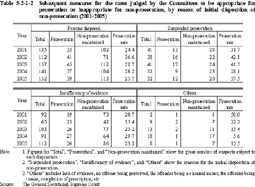| Previous Next Index Image Index Year Selection | |
|
|
1 Grievance system against non-prosecution The right to prosecute is exclusively granted to public prosecutors. Public prosecutors are also granted broad discretion upon prosecution. However, a public prosecutor may misjudge a case and make a decision of non-prosecution against a suspect who should be prosecuted. For this reason, legal procedures have been established for the relief of complainants, victims and others against the disposition of non-prosecution by a public prosecutor. Under this system, it is allowed to request reviews by the Committees for the Inquest of Prosecution and to file applications for committing a case to a competent district court for trial (also called the quasi-prosecution procedure).
(1) Request for reviews by Committee for the Inquest of Prosecution A total of 201 Committees for the Inquest of Prosecution are established nationwide, each with 11 members chosen by lot from the electoral roll for a term of six months. By request or ex officio, a Committee reviews the disposition of non-prosecution made by a public prosecutor and make a judgment of the case being "appropriate for prosecution", "inappropriate for non-prosecution" or "appropriate for non-prosecution."
Furthermore, the Act for Partial Amendment to the Code of Criminal Procedure etc. (Act No. 62 of 2004) partially amended the Act for the Inquest of Prosecution (Act No. 147 of 1948). The amendment introduced a system where public prosecution can be instituted based on a decision of the Committees for the Inquest of Prosecution under certain circumstances. The part of this Act pertaining to this system is scheduled to be enforced by May 2009 (see Part 6, Chapter 5, Section 3). Table 5-2-1-1 shows the number of persons received and disposed by the Committees over the last 10 years. Table 5-2-1-1 Number of persons received and disposed by Committees for the Inquest of Prosecution (1996-2005) In 2005, the Committees newly received 2,402 persons for penal code offenses. By type of offense, the greatest number of them (435 persons) were received for abuse of authority, followed by 425 persons for causing death or injury through negligence in the pursuit of social activities, 262 for counterfeiting of documents, 241 for injury or injury causing death, and 195 for fraud. In contrast, 246 persons were newly received for special act offenses. The greatest number of them (47 persons) were received for violations of the Labor Standard Act (Source: The General Secretariat, Supreme Court).Table 5-2-1-2 shows subsequent measures taken by public prosecutors for the cases judged by the Committee to be appropriate for prosecution or inappropriate for non-prosecution, by reason of initial disposition of non-prosecution, over the last five years. Table 5-2-1-2 Subsequent measures for the cases judged by the Committees to be appropriate for prosecution or inappropriate for non-prosecution, by reason of initial disposition of non-prosecution (2001-2005) In total, 145,579 persons were disposed by the Committees between 1949 (when the Act for the Inquest of Prosecution took effect) and 2005, including 16,938 persons judged to be appropriate for prosecution or inappropriate for non-prosecution. Among them, prosecution was instituted for 1,306 persons, and 1,150 were convicted (396 sentenced to imprisonment and 754 to fine) and 77 were found not guilty (including dismissal for judicial bar and dismissal of prosecution) (Source: The General Secretariat, Supreme Court).(2) Application to commit a case to a court for trial Application to commit a case to a court for trial is the system which allows complainants or accusers, who have an objection to a public prosecutor's disposition of non-prosecution for various types of abuse of authority, to request the competent district court to commit a case for trial.
When there seems to exist a reason for such request, the district courts makes a determination to commit the case to a trial. Due to such determination, a public prosecution is deemed to be raised, and the court designates a person who maintains the public prosecution among the lawyers, and has him perform the duties of a prosecutor. In 2005, the number of persons received was 460 and the number of persons disposed was 347. Commitment of the case to a court for trial was not decided for any of these cases (Source: Annual Report of Judicial Statistics and The General Secretariat, Supreme Court). |

